Design and Validation of a Stratified Shear Model Box for Seismic Response of a Sand-Blowing Reclamation Site
Abstract
:1. Introduction
2. Devices and Materials Utilized for the Shaking-Table Test
2.1. Shaking Table
2.2. Model Box Design
- Durability: it should be robust enough to prevent instability or damage during vibrations.
- Size considerations: it must be properly sized to ensure that the total weight remains within the maximum capacity of the shaking table.
- Resonance avoidance: resonance with the self-vibration frequencies of the model soil should be avoided.
- Boundary effect reduction: efforts must be made to minimize boundary effects.
2.3. Loading Device
2.4. Sensors
3. Model Construction
3.1. Test Soil
3.2. Model Filling
3.3. Similarity Relationships
3.4. Design of Experimental Conditions
3.5. Limitations of the Study
- (1)
- The input waves for our experiments were 1 Hz and 5 Hz sine waves, which substantially differ from the complex frequency patterns of seismic waves occurring in natural earthquakes.
- (2)
- While our study focused on the effects of varying consolidation pressures on site seismic responses, these responses are also influenced by factors including groundwater levels and the magnitudes of seismic accelerations.
- (3)
- Furthermore, the fixed dimensions of our model box restrict our ability to explore the differences in vibration characteristics among models of varying sizes.
4. Results and Discussion
4.1. Testing of Boundary Effects
4.2. Testing of Consolidation Effect
4.3. The Site’s Predominant Period
4.4. Liquefaction of Sand Soil Layers
4.5. Discussion
5. Conclusions
- (1)
- The stratified shearing model box experiences minimal boundary effects. Under the test conditions of inputting a 1 Hz sine wave with an acceleration amplitude of 0.05 g, and a 5 Hz sine wave with an acceleration amplitude of 0.05 g, the influence factor DA (%) of the box boundaries on the top and middle soil layers varied from 3.27% to 5.78%.
- (2)
- The loading system was effective in maintaining pressure and settlement close to the predetermined values, with minimal impact of load variation during the experiments. When pressures of 10, 20, and 30 kPa were applied by the loading system, the model soil experienced maximum settlements of −15.963, −31.436, and −39.265 mm, respectively. After the release of pressure, the soil rebound was measured to be 1.653, 3.626, and 4.634 mm, respectively.
- (3)
- Changes in consolidation pressure and soft soil properties lead to shifts in the site’s predominant period. As the consolidation pressure in the soil layer increases from 0 kPa to 30 kPa, the predominant period decreases from 0.181 s to 0.131 s. At the same consolidation pressures, the predominant period of the sand soil layer is shorter compared to the entire site. This suggests that the presence of soft-soil layers shifts the site’s predominant period towards longer durations.
- (4)
- When the period of the input wave aligns with the site’s period, resonance occurs, amplifying seismic vibrations. As the period diverges from the site’s predominant period, the resonance effect weakens. At 0 kPa consolidation pressure, the site’s predominant period is 0.181 s, closely aligning with the 5 Hz sine period. This alignment maximizes both the ground motion amplification factor and the Arias intensity amplification factor. As consolidation pressure increases and the input wave’s period further diverges from the site’s predominant period, both the ground motion amplification factor and the Arias intensity amplification factor exhibit a decreasing trend.
Author Contributions
Funding
Data Availability Statement
Acknowledgments
Conflicts of Interest
References
- Işık, E. Structural failures of adobe buildings during the February 2023 Kahramanmaraş (Türkiye) earthquakes. Appl. Sci. 2023, 13, 8937. [Google Scholar] [CrossRef]
- Essar, M.Y.; Wahdati, S.; O’Sullivan, B.; Nemat, A.; Blanchet, K. Cycles of disasters in Afghanistan: The urgent call for global solidarity. PLoS Glob. Public Health 2024, 4, e0002751. [Google Scholar] [CrossRef] [PubMed]
- Yeck, W.L.; Hatem, A.E.; Goldberg, D.E.; Barnhart, W.D.; Jobe, J.A.T.; Shelly, D.R.; Villaseñor, A.; Benz, H.M.; Earle, P.S. Rapid Source Characterization of the 2023Mw 6.8 Al Haouz, Morocco, Earthquake. Seism. Rec. 2023, 3, 357–366. [Google Scholar] [CrossRef]
- Singh, S.K.; Mena, E.A.; Castro, R. Some aspects of source characteristics of the 19 September 1985 Michoacan earthquake and ground motion amplification in and near Mexico City from strong motion data. Bull. Seismol. Soc. Am. 1988, 78, 451–477. [Google Scholar]
- Campillo, M.; Gariel, J.C.; Aki, K.; Sánchez-Sesma, F.J. Destructive strong ground motion in Mexico City: Source, path, and site effects during great 1985 Michoacán earthquake. Bull. Seismol. Soc. Am. 1989, 79, 1718–1735. [Google Scholar] [CrossRef]
- Housner, G.W.; Thiel, C.C. Competing against time: Report of the Governor’s Board of Inquiry on the 1989 Loma Prieta earthquake. Earthq. Spectra 1990, 6, 681–711. [Google Scholar] [CrossRef]
- Mitchell, D.; Tinawi, R.; Sexsmith, R. Performance of bridges in the 1989 Loma Prieta earthquake—Lessons for Canadian designers. Can. J. Civ. Eng. 1991, 18, 711–734. [Google Scholar] [CrossRef]
- Mitchell, D.; Tinawi, R.; Redwood, R. Damage to buildings due to the 1989 Loma Prieta earthquake—A Canadian code perspective. Can. J. Civ. Eng. 1990, 17, 813–834. [Google Scholar] [CrossRef]
- Anderson, J.G.; Bodin, P.; Brune, J.N.; Prince, J.; Singh, S.K.; Quaas, R.; Onate, M. Strong ground motion from the Michoacan, Mexico, earthquake. Science 1986, 233, 1043–1049. [Google Scholar] [CrossRef]
- Jaimes, M.A.; Lermo, J.; García-Soto, A.D. Ground-motion prediction model from local earthquakes of the Mexico basin at the hill zone of Mexico City. Bull. Seismol. Soc. Am. 2016, 106, 2532–2544. [Google Scholar] [CrossRef]
- Gülü, A. A Compendious Review on the Determination of Fundamental Site Period: Methods and Importance. Geotechnics 2023, 3, 71. [Google Scholar] [CrossRef]
- Chu, J.; Bo, M.W.; Arulrajah, A. Soil improvement works for an offshore land reclamation. Proc. Inst. Civ. Eng. Geotech. Eng. 2009, 162, 21–32. [Google Scholar] [CrossRef]
- Noda, T.; Nakai, K.; Asaoka, A. Seismic response analysis of a coastal artificial reclaimed ground containing a soft layer. IOP Conf. Ser. Mater. Sci. Eng. 2010, 10, 012107. [Google Scholar] [CrossRef]
- Vitale, S.; Isaia, R.; Ciarcia, S.; Giuseppe, M.G.; Iannuzzi, E.; Prinzi, E.; Tramparulo, F.; Troiano, A. Seismically Induced Soft-Sediment Deformation Phenomena During the Volcano-Tectonic Activity of Campi Flegrei Caldera (Southern Italy) in the Last 15 kyr. Tectonics 2019, 38, 1999–2018. [Google Scholar] [CrossRef]
- Ovando-Shelley, E.; Romo, M.P.; Contreras, N.; Giralt, A. Effects on soil properties of future settlements in downtown Mexico City due to ground water extraction. Geofísica Int. 2003, 42, 185–204. [Google Scholar] [CrossRef]
- Lermo, J.; Chávez-García, F.J. Site effect evaluation at Mexico City: Dominant period and relative amplification from strong motion and microtremor records. Soil Dyn. Earthq. Eng. 1994, 13, 413–423. [Google Scholar] [CrossRef]
- Alam, M.J.; Azad, A.; Rahman, Z. Prediction of Liquefaction Potential of Dredge Fill Sand by DCP and Dynamic Probing. AIP Conf. Proc. 2008, 1020, 296–303. [Google Scholar]
- Hu, J.; Liu, Y.; Yao, K.; Wei, H. Observation of Reinforcement Methods in Organic Disseminated Sand. In Proceedings of the International Conference on Transportation & Mechanical & Electrical Engineering (ICTMEE 2017), Qingdao, China, 9–12 June 2017. [Google Scholar]
- Lv, J.; Yin, Y.; Yu, Z.; Xu, Z.C.; Chen, G.F.; Yang, F. Study on Light Dynamic Penetration to Test Coarse Sand Relative Density in Bridge Culvert Back Sand Filling. In Proceedings of the International Conference on Transportation & Mechanical & Electrical Engineering (ICTMEE 2017), Qingdao, China, 9–12 June 2017. [Google Scholar]
- Kim, H.; Prezzi, M.; Salgado, R. Use of Dynamic Cone Penetration and Clegg Hammer Tests for Quality Control of Roadway Compaction and Construction; Joint Transportation Research Program: West Lafayette, IN, USA, 2010. [Google Scholar]
- Li, Y.; Cui, J.; Guan, T.; Jing, L. Investigation into dynamic response of regional sites to seismic waves using shaking table testing. Earthq. Eng. Eng. Vib. 2015, 14, 411–421. [Google Scholar] [CrossRef]
- Dietz, M.; Wood, D.M. Shaking table evaluation of dynamic soil properties. In Proceedings of the 4th International Conference on Earthquake Geotechnical Engineering, Thessaloniki, Greece, 25–28 June 2007. [Google Scholar]
- Afacan, K.B.; Brandenberg, S.J.; Stewart, J.P. Centrifuge modeling studies of site response in soft clay over wide strain range. J. Geotech. Geoenvironmental Eng. 2013, 140, 04013003. [Google Scholar] [CrossRef]
- Wang, X.; Li, J.C. Numerical study on the boundary effect of rigid model boxes in shaking table tests in underground engineering. IOP Conf. Ser. Earth Environ. Sci. 2021, 861, 052033. [Google Scholar] [CrossRef]
- Hashemi, S.; Ehtisham, A.; Rahmani, B. Dynamic behavior of elevated and ground-supported, base-isolated, flexible, concrete cylindrical fluid containers. J. Struct. Constr. Eng. 2021, 8, 345–366. [Google Scholar]
- Chen, M.; Ouyang, M.; Guo, H.; Zou, M.; Zhang, C. A Coupled Hydrodynamic–Structural Model for Flexible Interconnected Multiple Floating Bodies. J. Mar. Sci. Eng. 2023, 11, 813. [Google Scholar] [CrossRef]
- Matsuda, T.; Goto, Y. Studies on experimental technique of shaking table test for geotechnical problem. In Proceedings of the 9th World Conference on Earthquake Engineering, Tokyo, Japan, 2–9 August 1988. [Google Scholar]
- Whitman, R.V.; Lambe, P.C. Effect of boundary conditions upon centrifuge experiments using ground motion simulation. Geotech. Test. J. 1986, 9, 61–71. [Google Scholar] [CrossRef]
- Castelli, F.; Grasso, S.; Lentini, V.; Sammito, M. Design of a Biaxial Laminar Shear Box for 1g Shaking Table Tests. Geotechnics 2022, 2, 23. [Google Scholar] [CrossRef]
- Cheng, Z.; Li, J.; Wu, C.; Zhang, T.; Du, G. Axial Compressive Performance of Steel-Reinforced UHPC-Filled Square Stainless-Steel Tube. Buildings 2022, 13, 56. [Google Scholar] [CrossRef]
- Lee, C.J.; Wei, Y.C.; Kuo, Y.C. Boundary effects of a laminar container in centrifuge shaking table tests. Int. J. Soil Dyn. Earthq. Eng. 2012, 34, 37–51. [Google Scholar] [CrossRef]
- Vo, T.; Thai, H.; Inam, F. Axial-flexural coupled vibration and buckling of composite beams using sinusoidal shear deformation theory. Arch. Appl. Mech. 2012, 82, 1391–1408. [Google Scholar] [CrossRef]
- Glogowski, P.; Rieger, M.; Sun, J.; Kuhlenkötter, B. Natural Frequency Analysis in the Workspace of a Six-Axis Industrial Robot Using Design of Experiments. Adv. Mater. Res. 2016, 1140, 345–352. [Google Scholar] [CrossRef]
- Hardin, B.O.; Drnevich, V.P. Shear modulus and damping in soils: Measurement and parameter effects (Terzaghi lecture). J. Soil Mech. Found. Div. 1972, 98, 603–624. [Google Scholar] [CrossRef]
- Dietz, M.; Wood, D.M. Shaking Table Evaluation of Dynamic Soil Properties; Springer: Berlin/Heidelberg, Germany, 2007. [Google Scholar]
- Ha, I.-S.; Olson, S.M.; Seo, M.-W.; Kim, M.-M. Evaluation of reliquefaction resistance using shaking table tests. Soil Dyn. Earthq. Eng. 2011, 31, 682–691. [Google Scholar] [CrossRef]
- Málaga-Chuquitaype, C. Strong-motion duration and response scaling of yielding and degrading eccentric structures. Earthq. Eng. Struct. Dyn. 2020, 49, 1453–1471. [Google Scholar] [CrossRef]
- Wood, D.M.; Crewe, A.; Taylor, C. Shaking table testing of geotechnical models. Int. J. Phys. Model. Geotech. 2002, 2, 1–13. [Google Scholar] [CrossRef]
- Carlos, G.; Singh, S.K. A site effect study in Acapulco, Guerrero, Mexico: Comparison of results from strong-motion and microtremor data. Bull. Seismol. Soc. Am. 1992, 82, 642–659. [Google Scholar]
- Prasad, S.K.; Towhata, I.; Chandradhara, G.P.; Nanjundaswamy, P. Shaking table tests in earthquake geotechnical engineering. Curr. Sci. 2004, 87, 1398–1404. [Google Scholar]
- Xie, L.; Zhou, Y.; Hu, C.; Yu, H. Characteristics of response spectra of long-period earthquake ground motion. Earthq. Eng. Eng. Vib. 1990, 10, 1–20. [Google Scholar]
- Avilés, J.; Pérez-Rocha, L.E. Regional subsidence of Mexico City and its effects on seismic response. Soil Dyn. Earthq. Eng. 2010, 30, 981–989. [Google Scholar] [CrossRef]
- Mayoral, J.M.; Castañón, E.; Albarrán, J. Regional subsidence effects on seismic soil-structure interaction in soft clay. Soil Dyn. Earthq. Eng.-Southampt. 2017, 103, 123–140. [Google Scholar] [CrossRef]
- Dobry, R.; Oweis, I.; Urzua, A. Simplified procedures for estimating the fundamental period of a soil profile. Bull. Seismol. Soc. Am. 1976, 66, 1293–1321. [Google Scholar]
- Cheng, C.-C.; Yu, C.-P.; Chang, H. On the Feasibility of Deriving Transfer Function from Rayleigh Wave in the Impact-Echo Displacement Waveform. Key Eng. Mater. 2004, 270–273, 1484–1491. [Google Scholar] [CrossRef]
- Lebrun, B.; Hatzfeld, D.; Bard, P.Y. Site effect study in urban area: Experimental results in Grenoble (France). Pure Appl. Geophys. 2001, 158, 2543–2557. [Google Scholar] [CrossRef]
- Yu, S.-H. Application of Parzen window in filter back projection algorithm. IOP Conf. Ser. Mater. Sci. Eng. 2018, 392, 062183. [Google Scholar] [CrossRef]
- Viti, S.; Tanganelli, M.; D’intinosante, V.; Baglione, M. Effects of soil characterization on the seismic input. J. Earthq. Eng. 2019, 23, 487–511. [Google Scholar] [CrossRef]
- Oka, F.; Sugito, M.; Yashima, A.; Furumoto, Y. Time dependent ground motion amplification at reclaimed land after the 1995 Hyogo-ken-Nanbu Earthquake. In Proceedings of the 12th World Conference on Earthquake Engineering, Auckland, New Zealand, 30 January–4 February 2000. [Google Scholar]


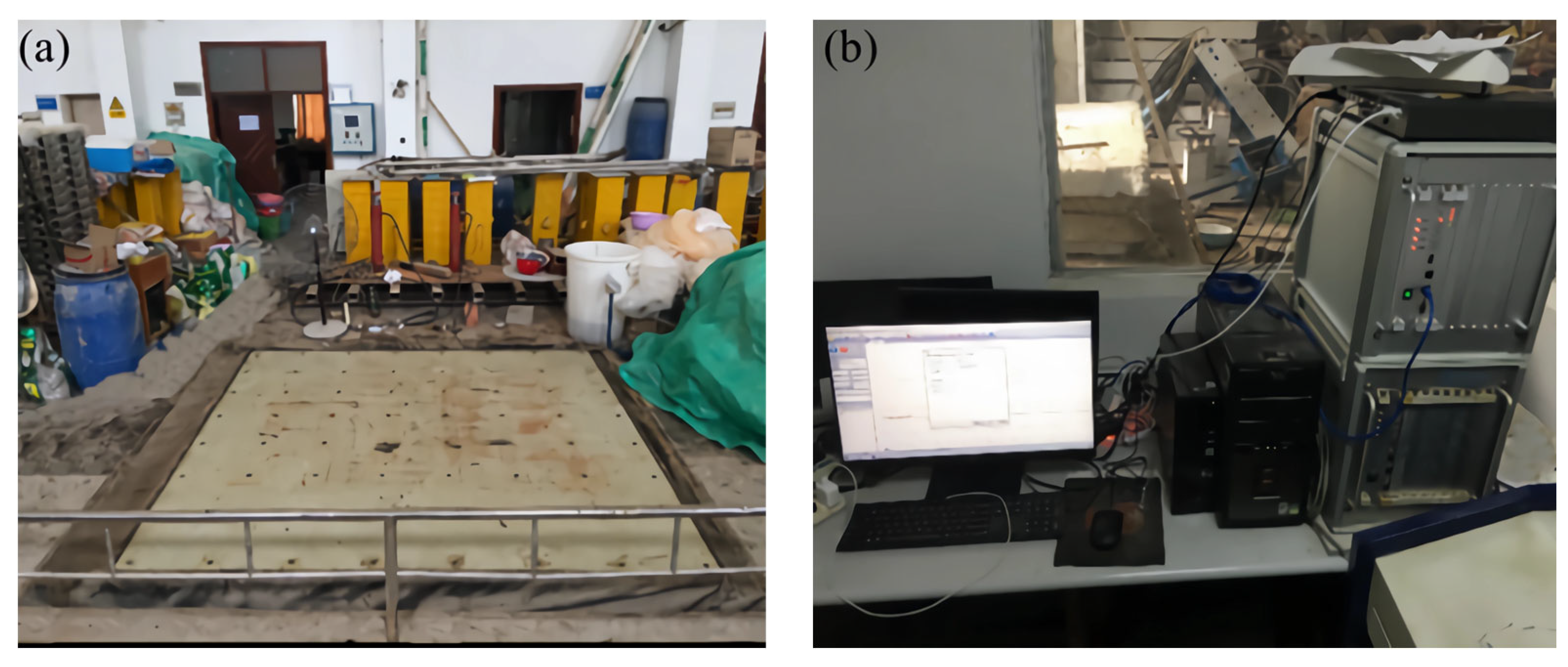
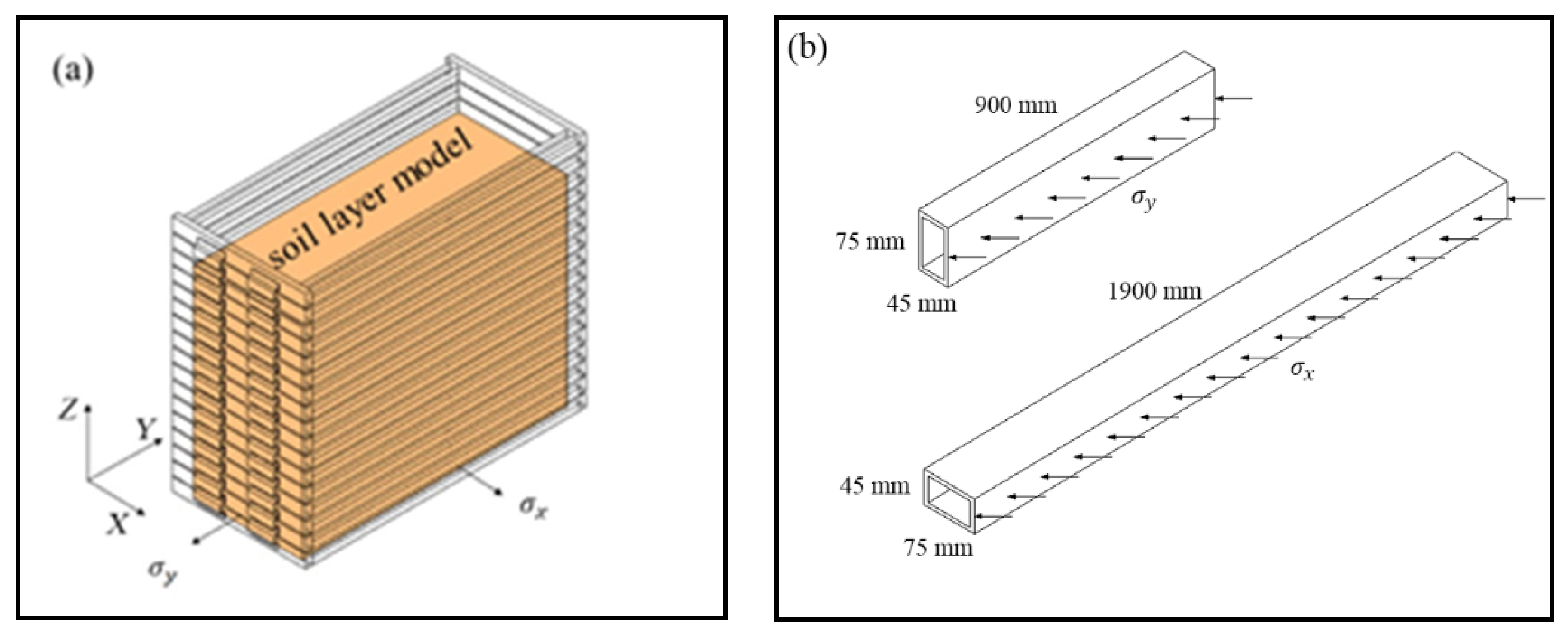

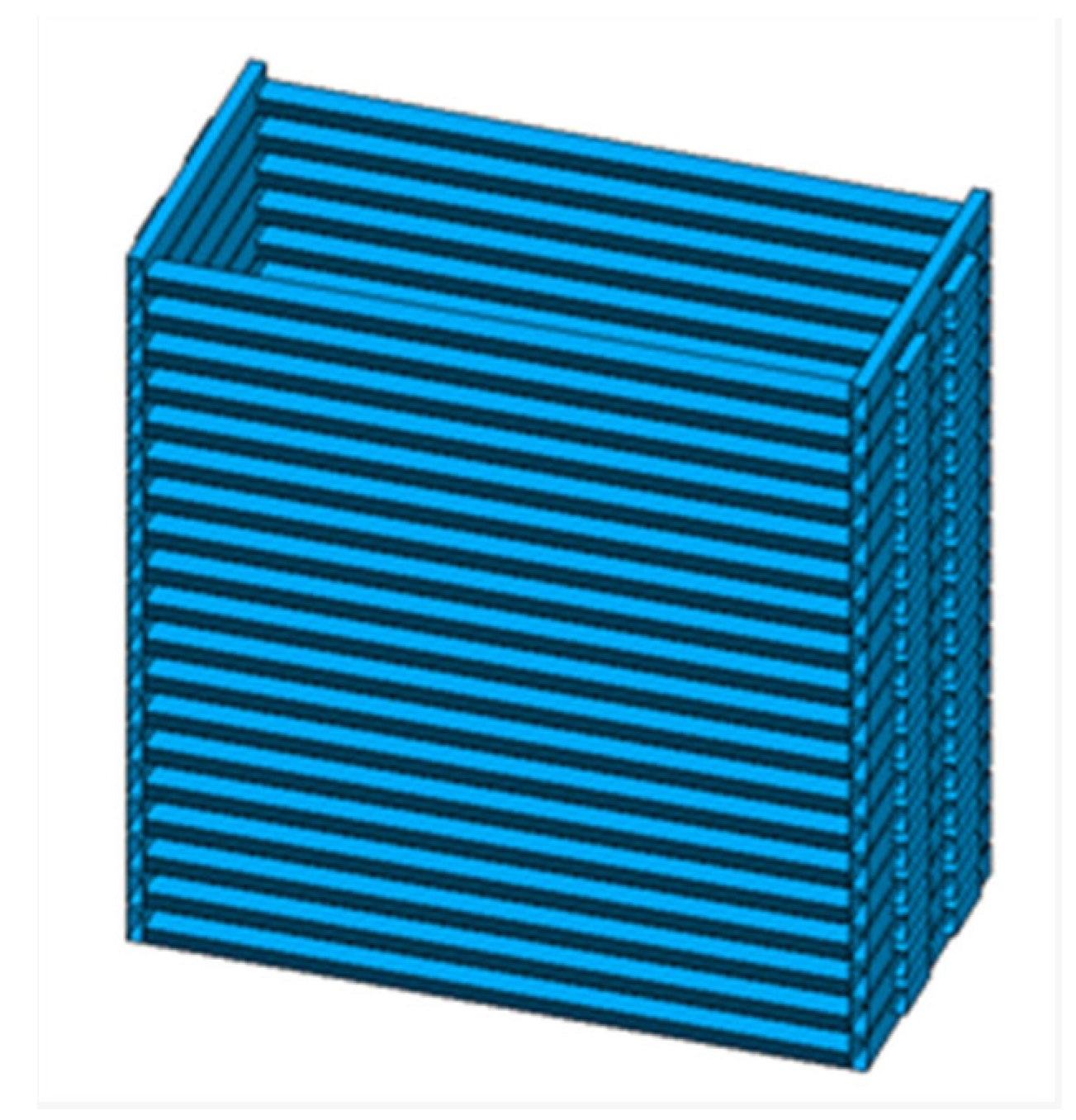
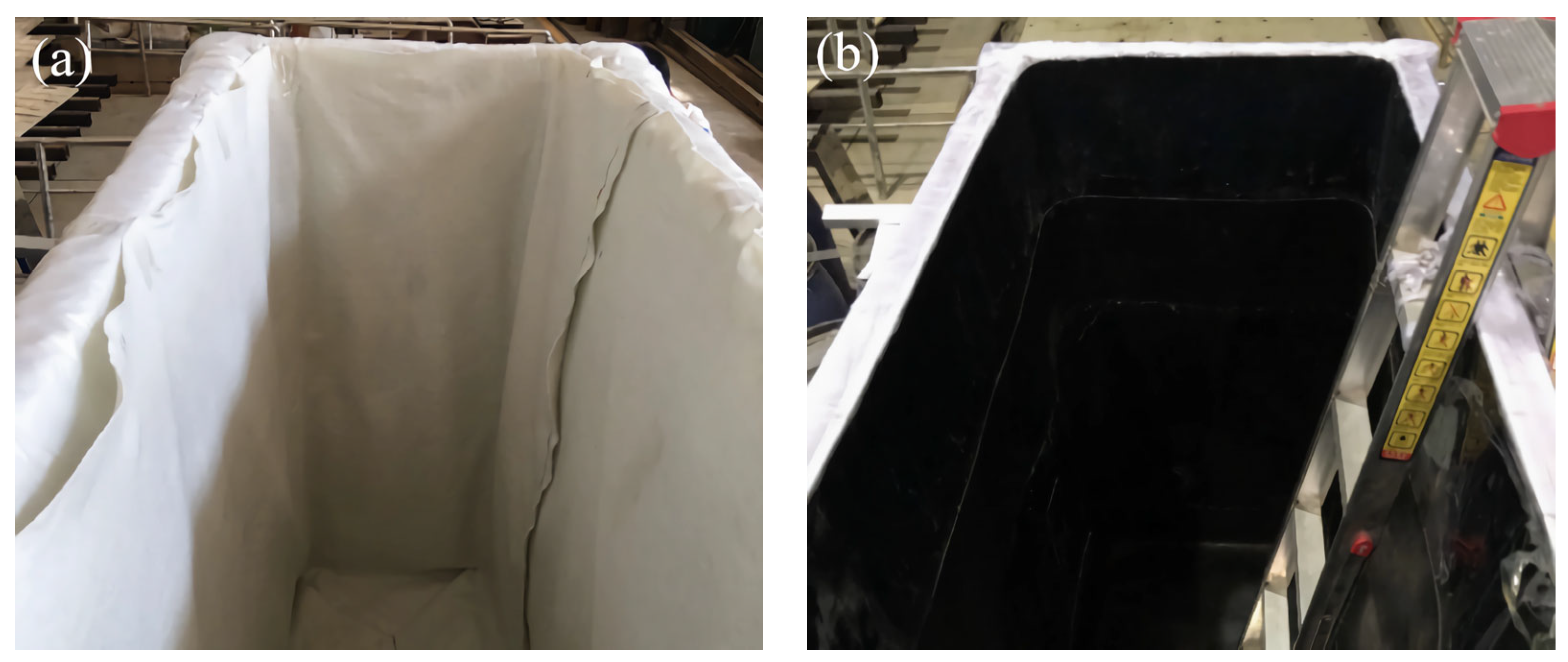
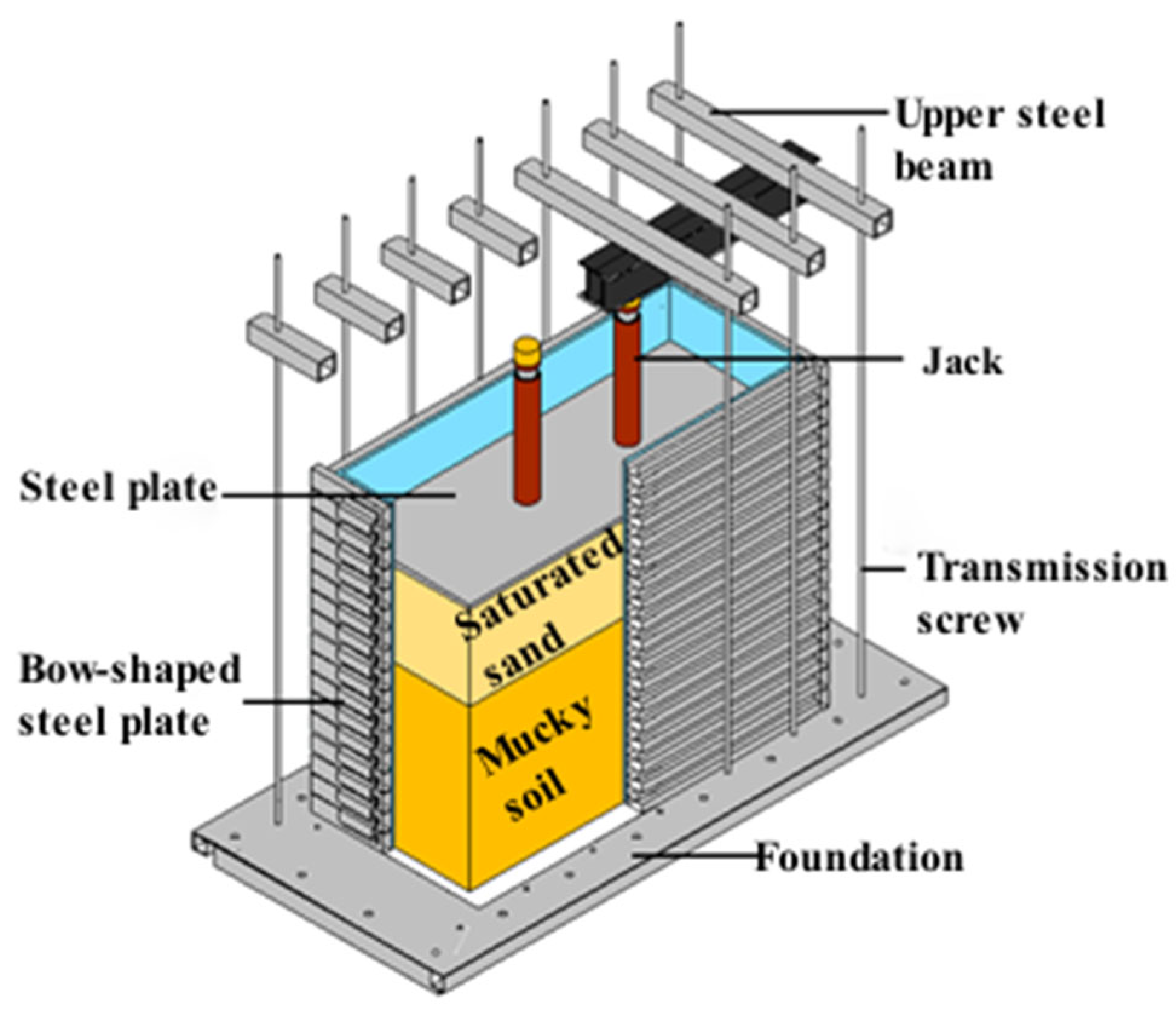
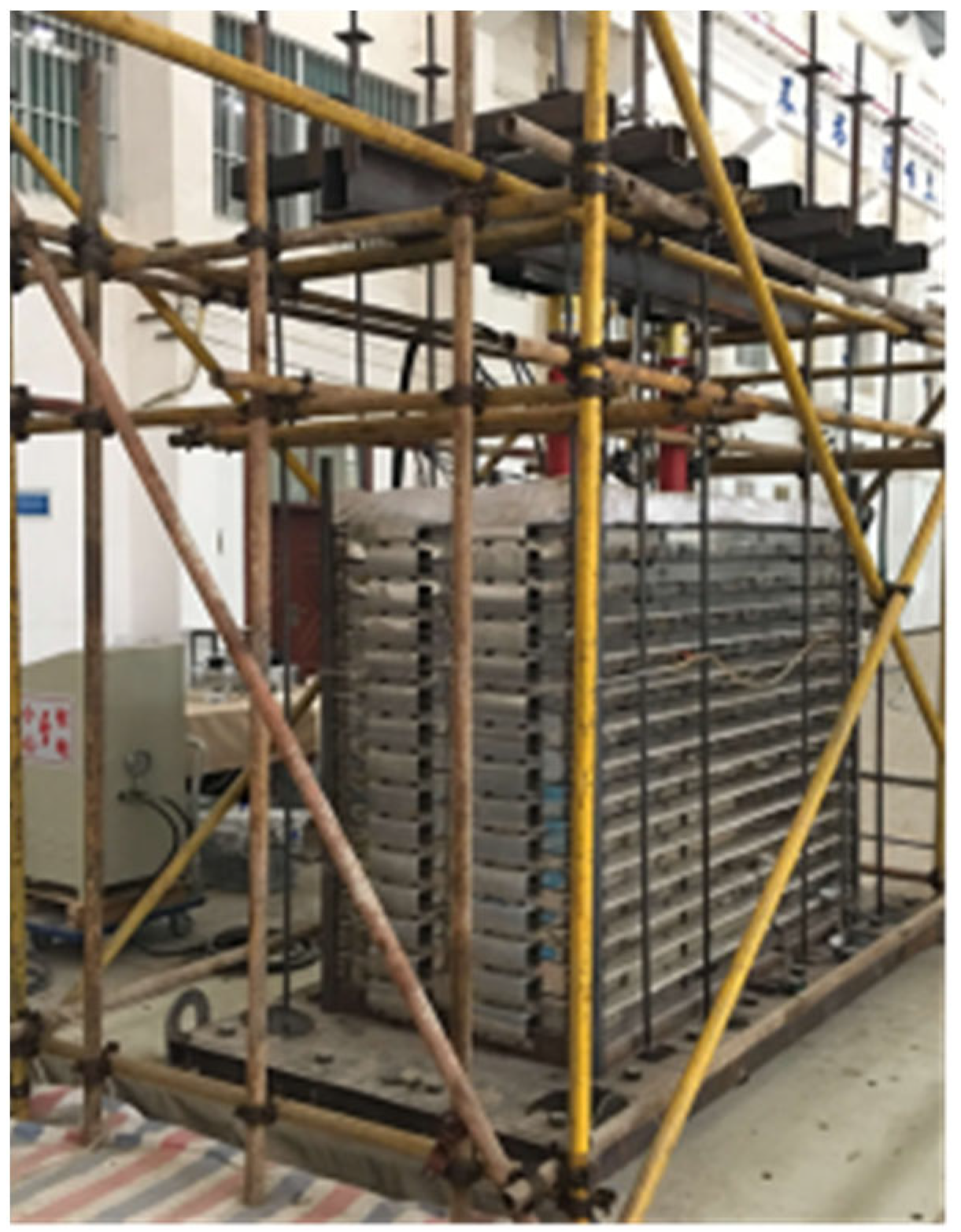
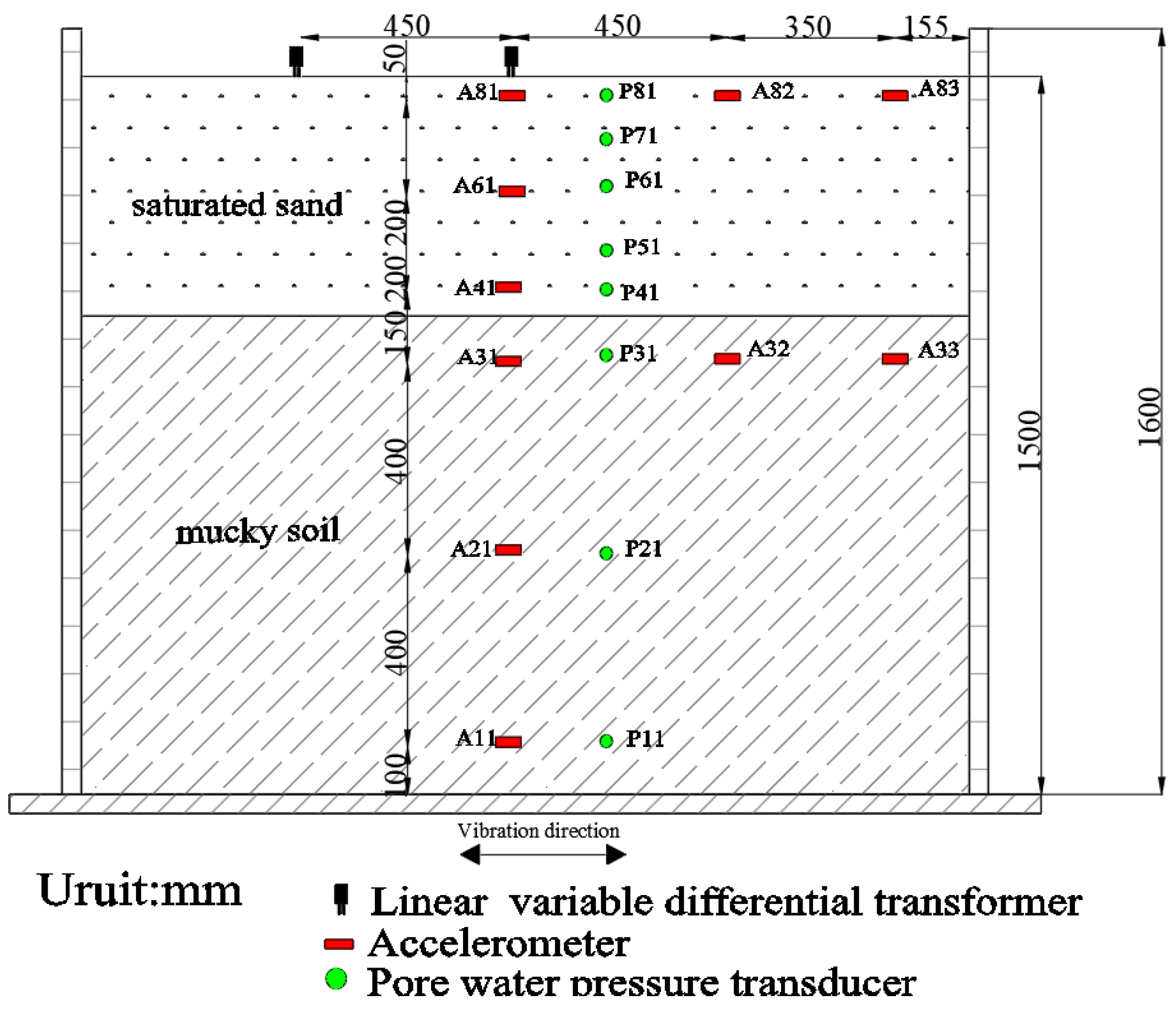
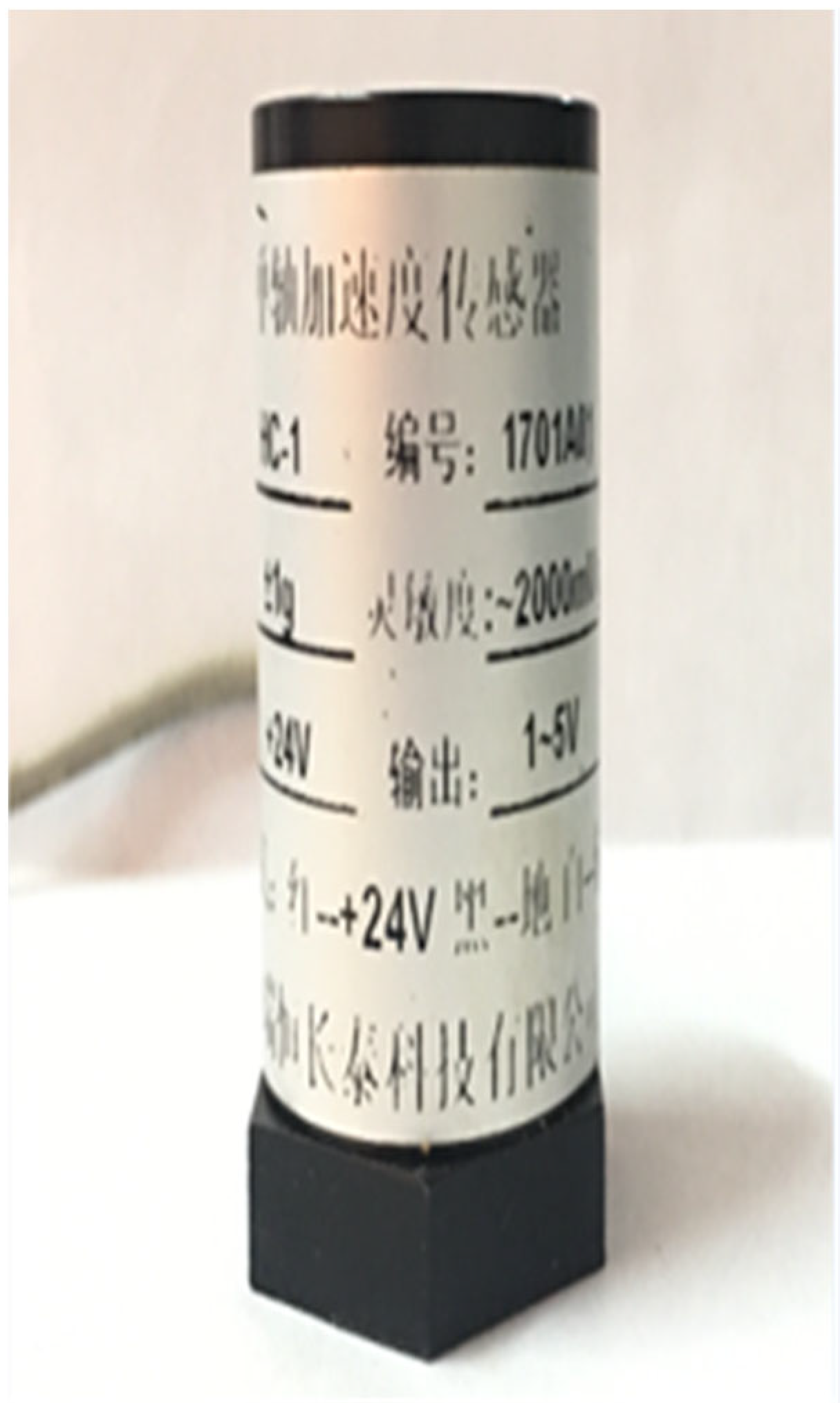

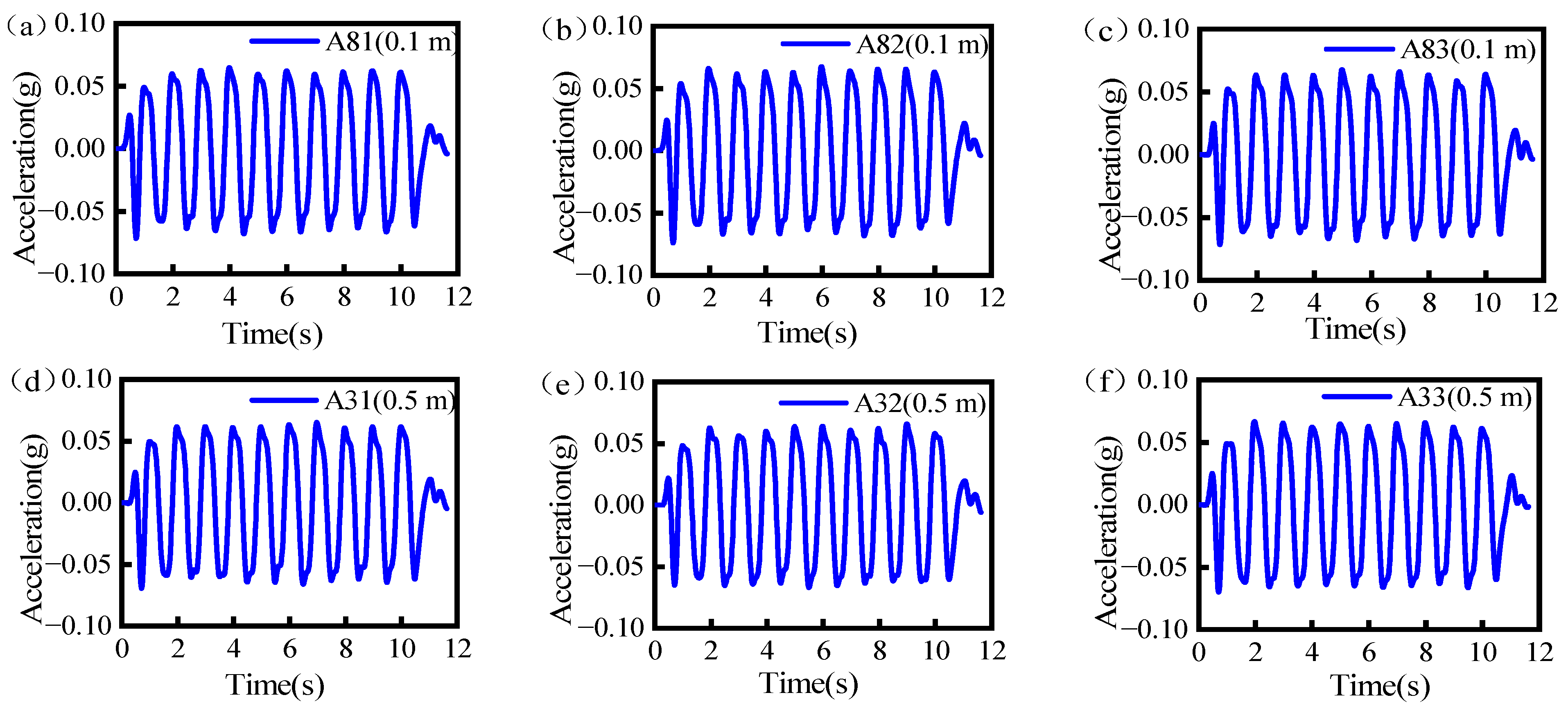

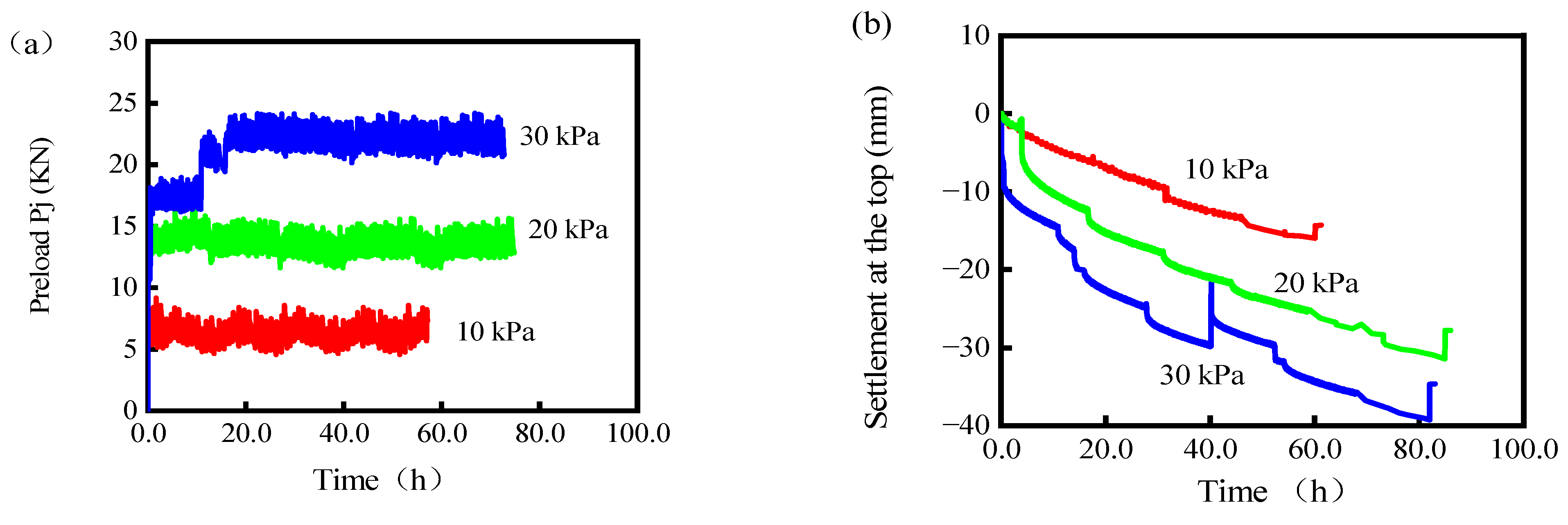
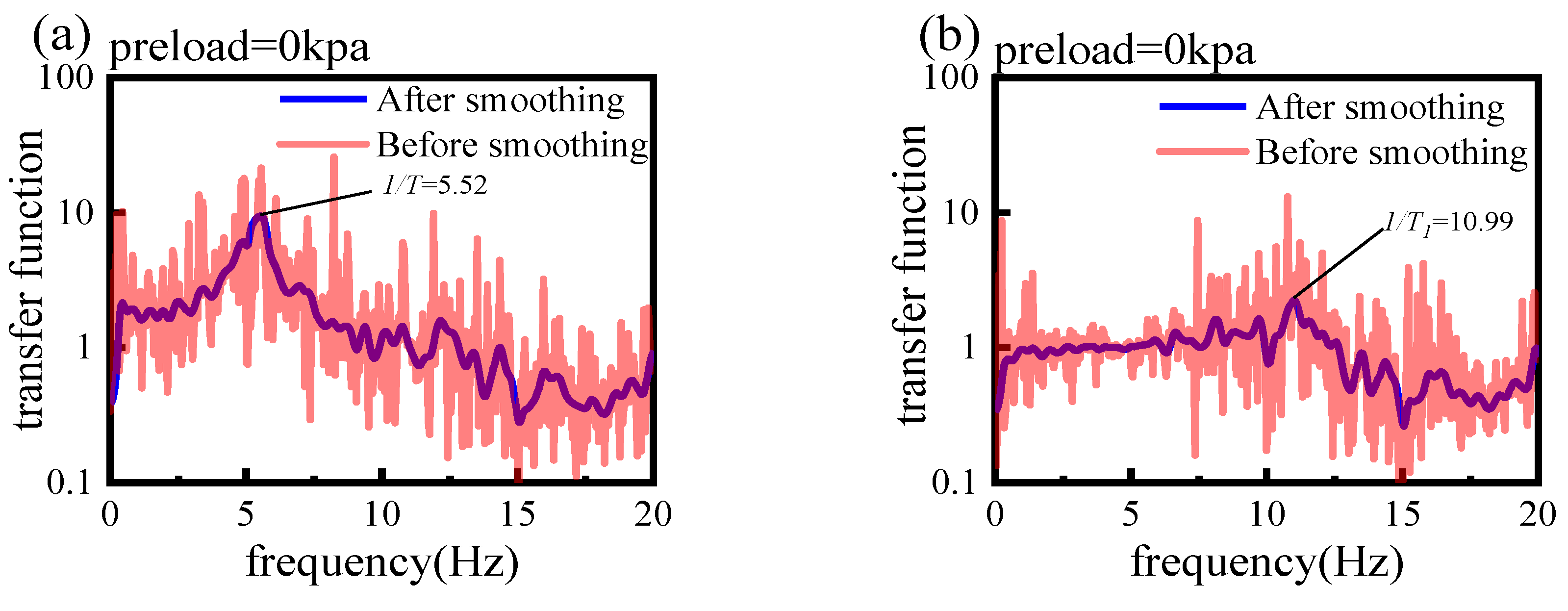
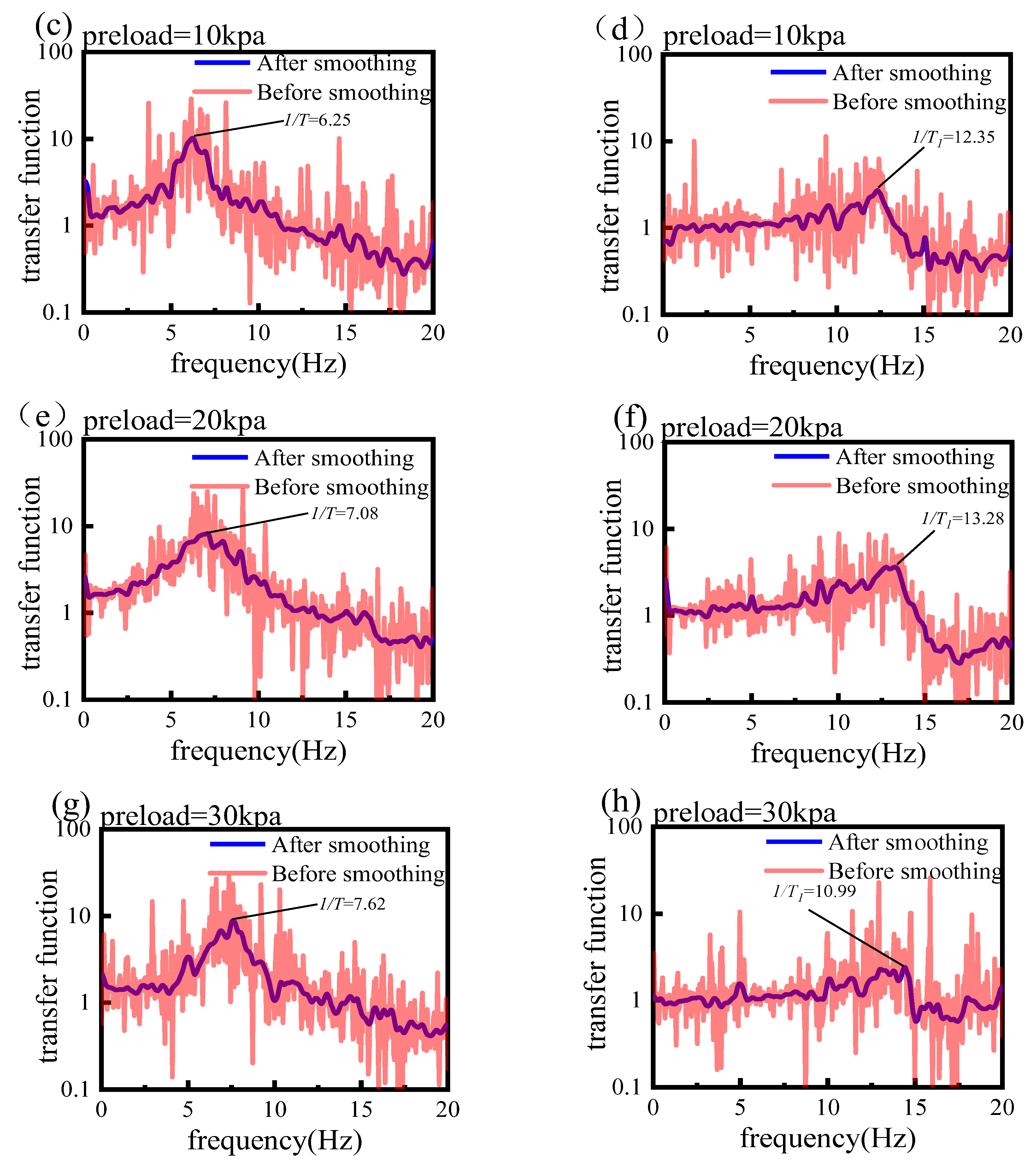
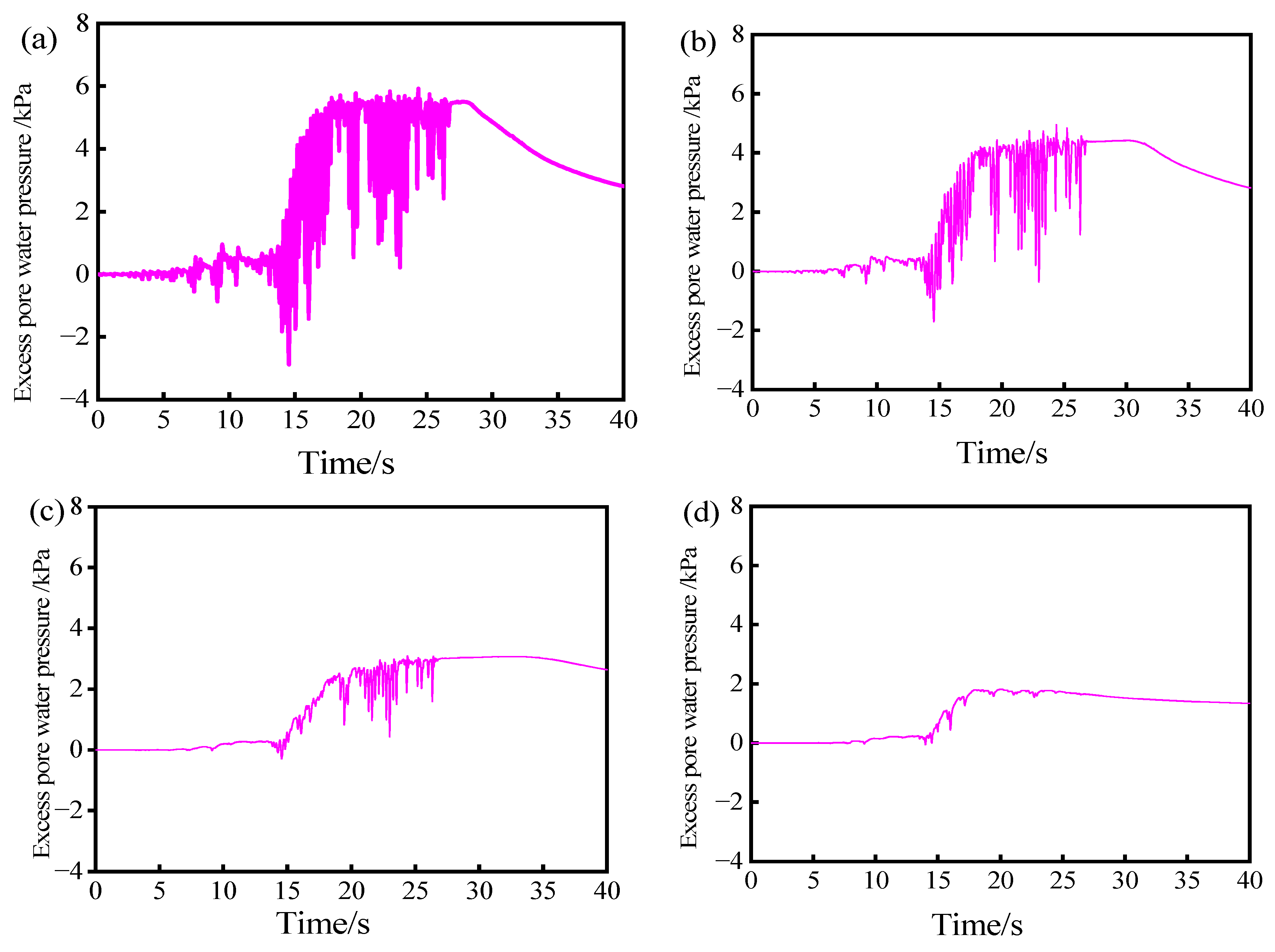
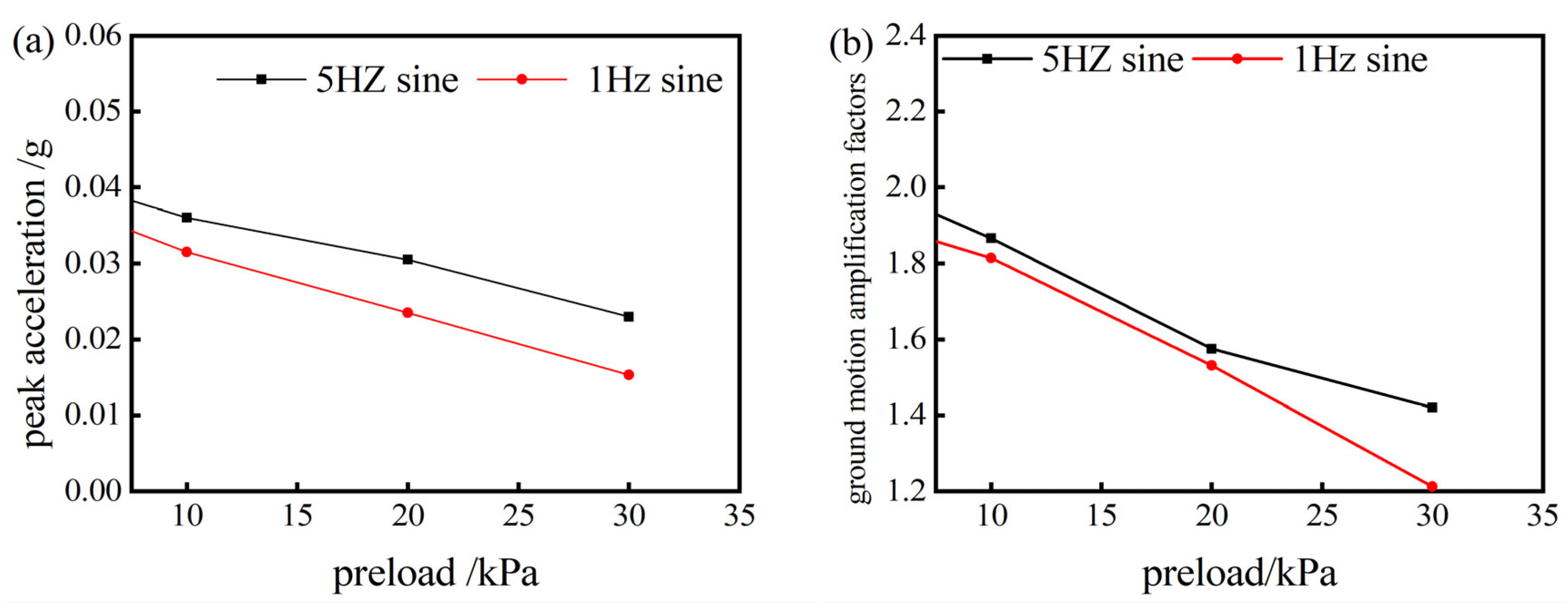
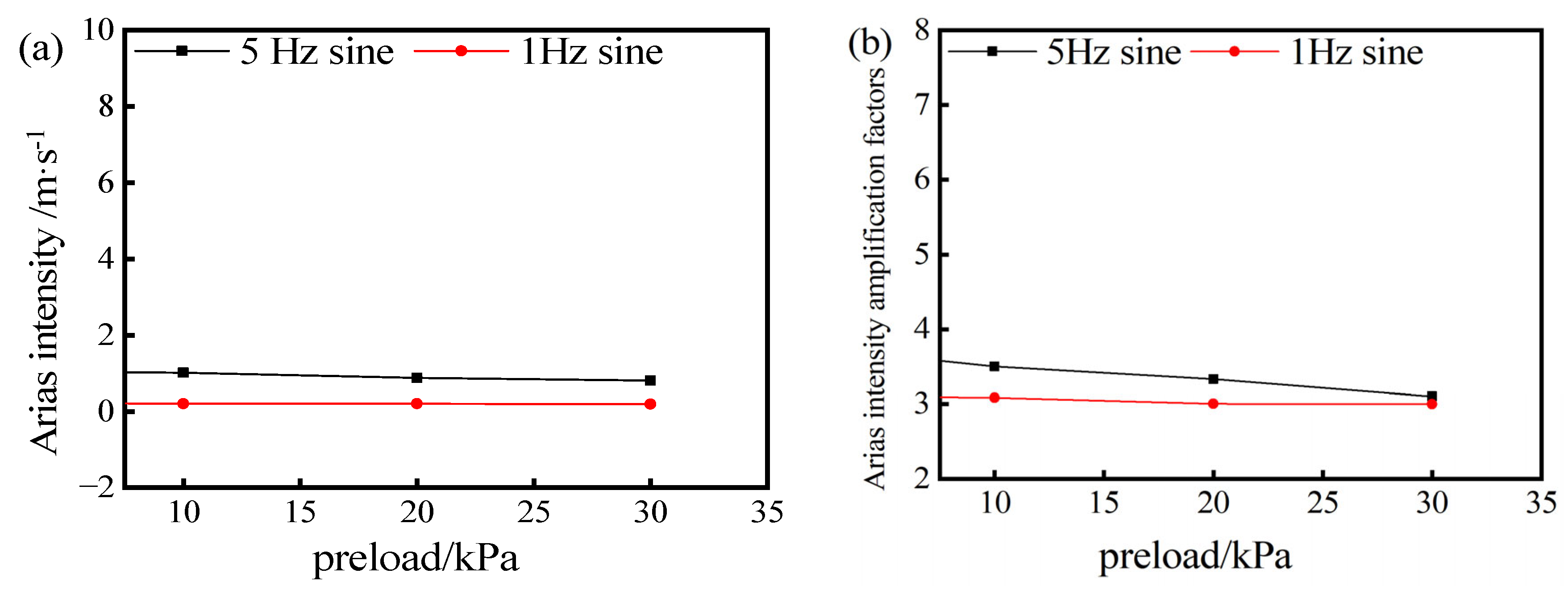
| Thickness/mm | 0.9 | 1 | 1.2 | 1.5 | 2 | 2.5 | 3 |
|---|---|---|---|---|---|---|---|
| Longitudinal tensile stress/MPa | 181.03 | 163.55 | 137.35 | 111.17 | 85.01 | 69.34 | 58.92 |
| Longitudinal shear stress/MPa | 17.21 | 15.50 | 12.95 | 10.40 | 7.84 | 6.31 | 5.29 |
| Short-axis tensile stress/MPa | 60.75 | 54.99 | 46.35 | 37.72 | 29.11 | 23.97 | 20.56 |
| Short-axis shear stress/MPa | 15.37 | 13.86 | 11.60 | 9.34 | 7.08 | 5.73 | 4.82 |
| Weight proportion/% | 3.77 | 4.18 | 5.01 | 6.23 | 8.27 | 10.28 | 12.26 |
| Thickness of the Steel Plate | 0.5 mm | 0.7 mm | 1.0 mm | 1.2 mm |
|---|---|---|---|---|
| First-order natural frequency of the model box/Hz | 0.7228 | 1.1800 | 1.9642 | 2.5352 |
| Second-order natural frequency of the model box/Hz | 2.1618 | 3.5284 | 5.8703 | 7.5730 |
| Third-order natural frequency of the model box/Hz | 3.5804 | 5.8416 | 9.7097 | 12.514 |
| Soft Soil | Physical Properties | Sandy Soil | Physical Properties |
|---|---|---|---|
| Moisture Content, (%) | 46.1 | Specific Gravity, (-) | 2.67 |
| Density, (g·cm−3) | 1.71 | Maximum Dry Density, (g·cm−3) | 1.702 |
| Porosity, (-) | 1.306 | Minimum Dry Density, (g·cm−3) | 1.430 |
| Liquid Limit, (%) | 44.2 | Maximum Void Ratio, (-) | 0.867 |
| Plastic Limit, (%) | 23.3 | Minimum Porosity, (-) | 0.568 |
| Permeability Coefficient, (10−6cm·s−1) | 6.653 | Relative Density | 0.558 |
| Variables | Dimension | Similarity Relationship | Similitude Ratio | |
|---|---|---|---|---|
| Model | Prototype | |||
| Length/l | L | Sl | 0.1 | 1 |
| Density/ρ | ML−3 | Sρ | 1 | 1 |
| Acceleration/a | LT | Sa | 1 | 1 |
| Time/t | LT | Sl1/2 × Sa−1/2 | 10−1/2 | 1 |
| Frequency/f | T−1 | Sl−1/2 × Sa1/2 | 101/2 | 1 |
| Displacement/s | L | Sl | 0.1 | 1 |
| Velocity/v | LT−1 | Sl1/2 × Sa1/2 | 10−1/2 | 1 |
| Stress/σ | ML−1T−2 | Sl × Sρ × Sa | 0.1 | 1 |
| Experiment Number | Preload | Consolidation Time | Input Wave |
|---|---|---|---|
| Test-1 | 0 | -- | White noise 1 Hz Sine wave, 5 Hz Sine wave |
| Test-2 | 10 | 3d | White noise 1 Hz Sine wave, 5 Hz Sine wave |
| Test-3 | 20 | 5d | White noise 1 Hz Sine wave, 5 Hz Sine wave |
| Test-4 | 30 | 5d | White noise 1 Hz Sine wave, 5 Hz Sine wave |
| Depth | Influence Factors | |||
|---|---|---|---|---|
| 1 Hz Sine Wave, Acceleration Amplitude of 0.05 g | 5 Hz Sine Wave, Acceleration Amplitude of 0.05 g | |||
| S-2 | S-3 | S-2 | S-3 | |
| 0.5 m | 3.67% | 3.27% | 5.78% | 4.45% |
| 0.1 m | 5.04% | 4.23% | 3.67% | 5.24% |
| Number | Preload/kPa | Predominant Periods/s | Shear Wave Velocity m/s | ||
|---|---|---|---|---|---|
| Surface (Entire Site) | Interface (Sand Soil) | Upper Layer (Sand Soil) | Bottom Layer (Soft Soil) | ||
| 1 | 0 | 0.181 | 0.091 | 26.37 | 37.33 |
| 2 | 10 | 0.160 | 0.081 | 29.65 | 42.43 |
| 3 | 20 | 0.141 | 0.075 | 31.88 | 49.34 |
| 4 | 30 | 0.131 | 0.069 | 34.57 | 52.85 |
Disclaimer/Publisher’s Note: The statements, opinions and data contained in all publications are solely those of the individual author(s) and contributor(s) and not of MDPI and/or the editor(s). MDPI and/or the editor(s) disclaim responsibility for any injury to people or property resulting from any ideas, methods, instructions or products referred to in the content. |
© 2024 by the authors. Licensee MDPI, Basel, Switzerland. This article is an open access article distributed under the terms and conditions of the Creative Commons Attribution (CC BY) license (https://creativecommons.org/licenses/by/4.0/).
Share and Cite
Li, J.; Wei, Y.; Liang, T.; Yan, Y.; Gao, Y.; Lu, X. Design and Validation of a Stratified Shear Model Box for Seismic Response of a Sand-Blowing Reclamation Site. Buildings 2024, 14, 1405. https://doi.org/10.3390/buildings14051405
Li J, Wei Y, Liang T, Yan Y, Gao Y, Lu X. Design and Validation of a Stratified Shear Model Box for Seismic Response of a Sand-Blowing Reclamation Site. Buildings. 2024; 14(5):1405. https://doi.org/10.3390/buildings14051405
Chicago/Turabian StyleLi, Jiaguang, Yi Wei, Tenglong Liang, Yuanfang Yan, Ying Gao, and Xiaoyan Lu. 2024. "Design and Validation of a Stratified Shear Model Box for Seismic Response of a Sand-Blowing Reclamation Site" Buildings 14, no. 5: 1405. https://doi.org/10.3390/buildings14051405




